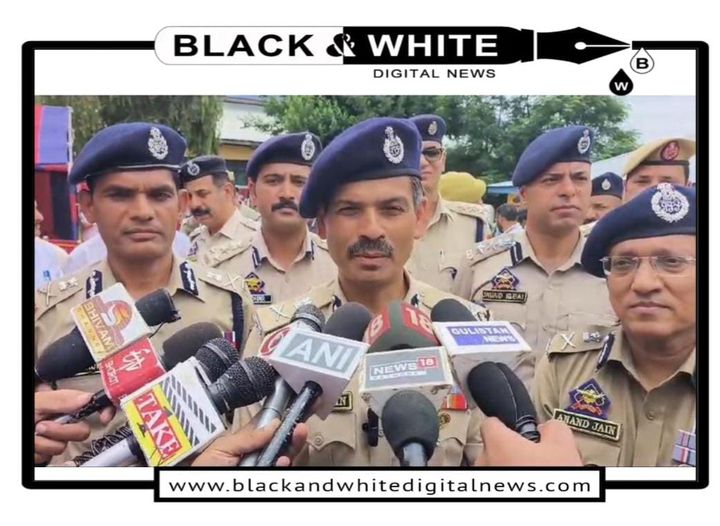J&K DGP Lauds Army, Police for Eliminating Foreign Terrorists in Udhampur Encounter: Discovery of NATO-Grade Arms Highlights Evolving Threat
||Black and White Digital News ||
||September 12,2024 ||
JAMMU: The Director General of Police (DGP) of Jammu and Kashmir, R.R. Swain, has hailed the successful elimination of two foreign terrorists in a joint operation carried out by the Indian Army’s White Knight Corps, Yole-based corps, and J&K Police in the dense mountainous region bordering Udhampur and Kathua districts. The operation, which took place in a challenging high-altitude jungle terrain, marks a significant victory against cross-border terrorism in the Union Territory.
Coordinated Efforts of Security Forces:
The DGP underscored the exemplary coordination between the Army and the J&K Police that led to the swift and precise neutralization of these foreign operatives. The operation highlighted the seamless synergy between the two forces, showcasing how such high-stakes missions are effectively handled through joint intelligence, reconnaissance, and ground execution. The encounter is part of ongoing efforts to tackle the persistent threat of foreign infiltration, particularly in areas that have become known for terrorist activity due to their proximity to the Line of Control (LoC).
NATO-Linked Arms Seizure: A Game Changer
One of the most alarming revelations from the encounter was the recovery of advanced weaponry typically associated with NATO forces. Among the seized arms were M-series rifles, equipped with night-vision devices (NVD) and telescopic sights, indicating that these foreign terrorists were not only highly trained but also came armed with military-grade equipment sourced from conflict zones outside India.
DGP Swain noted the significance of this discovery, suggesting that these arms were likely pilfered from international war theatres and routed to India for use by foreign mercenaries. The use of such advanced weaponry by terrorists in Jammu and Kashmir points to a disturbing trend of cross-border terrorism adopting global arms trafficking networks. The recovered rifles, enabled with night-fighting capabilities, are far more sophisticated than standard issue, further illustrating the lengths to which terrorist organizations are going to equip their operatives.
The Threat of Foreign Mercenaries:
The DGP’s statement also highlighted the evolving nature of terrorism in the region, with foreign terrorists now being armed with advanced equipment to carry out high-impact attacks. These foreign operatives, unlike local militants, often come with combat experience from other conflict zones and pose a greater threat to the region’s security. This operation, therefore, is seen as a significant victory not just in terms of eliminating two operatives, but in disrupting a larger plot that involved foreign-trained mercenaries using imported weaponry.
The ability of these foreign terrorists to access NATO-grade arms raises concerns about international terror funding and logistical support, necessitating closer scrutiny of cross-border and transnational networks that are enabling such flows of weapons into India. The encounter, therefore, points to a deeper security challenge in terms of countering not only local terrorism but also a growing influx of international operatives equipped with superior arms.
Growing Regional Instability and Response
The infiltration of foreign terrorists armed with sophisticated military equipment underscores the rising stakes in Jammu and Kashmir’s fight against terrorism. Security experts believe this is part of a broader strategy by hostile forces to destabilize the region using foreign fighters who are more experienced and better equipped than local militants. The successful neutralization of these terrorists serves as a warning to the broader network behind such operations that Indian forces remain vigilant and capable of thwarting even the most well-equipped foreign fighters.
DGP Swain’s commendation of the soldiers and police involved in the encounter reflects the ongoing efforts of Indian security forces to maintain peace in the region. Despite the increased sophistication of the threats they face, the forces remain resolute in their mission to secure the borders and prevent the influx of foreign militants.
The Udhampur encounter not only marks a tactical victory for Indian security forces but also raises important questions about the changing dynamics of terrorism in Jammu and Kashmir. With the discovery of NATO-grade arms, it is clear that foreign terrorists are being dispatched with more advanced tools and possibly with support from international terror networks. The Indian Army and J&K Police have once again demonstrated their ability to adapt to these evolving challenges, successfully neutralizing threats that could have had far-reaching consequences.
As the region continues to face attempts at destabilization, coordinated operations like this remain critical to ensuring the long-term security of Jammu and Kashmir. The vigilance, bravery, and strategic acumen displayed by the forces involved in this operation will likely serve as a template for future counter-terrorism efforts in the region.



